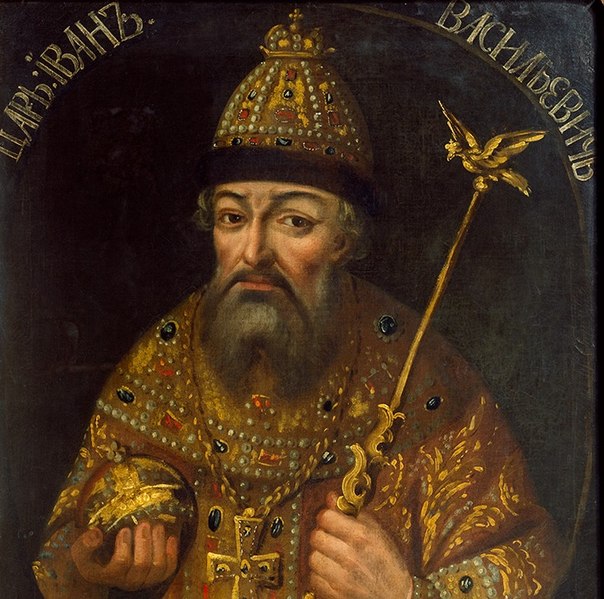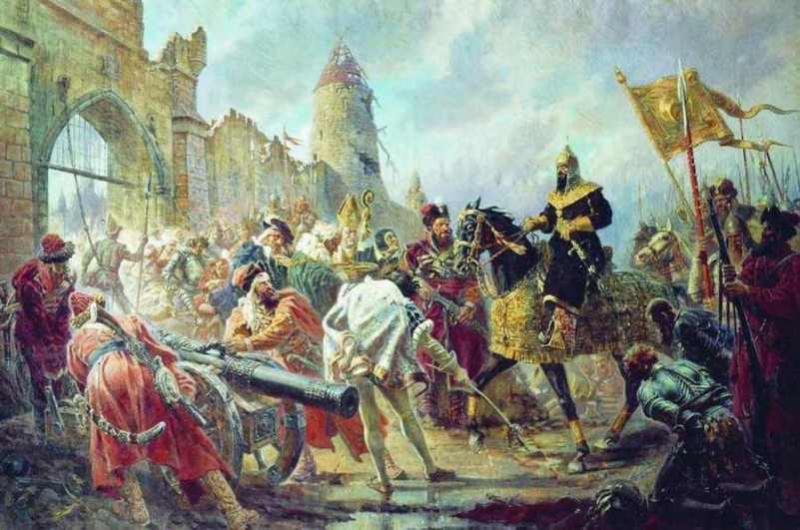
Ivan the TerribleIn the end of November 1563 year 80000th army of Ivan the Terrible came from Moscow and 4 December arrived in Mozhaisk. Formation of the Russian regiments ended in Pskov, all seven regiments were formed. already 9 January, the nomination of the Moscow troops to the city of Polotsk. After a fugitive traitor Hliznev-Kolycheva Polotsk learned of the approach of Russian troops. This was immediately reported Hetman Lithuanian H. Radziwill. Tsar Ivan the Terrible offered Lithuanian governor C. Dovoyne surrender the city, but I got no response; Furthermore, captive, released in Polotsk with this message, He was executed.
The siege of the city was completed by the end of August 1563 of the year. According to the plan of attack on the city we had to drive on the ice from Pārdaugava Western Dvina, as the roundabout city - "Great Ostrog" - had no walls from the side of the river; therefore Pardaugava are the most efficient part of the Moscow rati - Sovereign Regiment, Polk right hand and best regiment. At the beginning of the siege of gunfire, wore a local character. but 3 February changed the ice conditions on the Western Dvina, and the siege of the plan had to be changed.
Sovereign regiment was relocated in the area between the river Western Dvina fabrics and to lead the offensive after the strengthening of the Great Jail. In the meantime, to help Polotsk hurrying army of the Grand Duchy of Lithuania, led by Hetman H. I. Radziwill. Size of the army was 2500 – 3500 people with 20 – 25 field guns. Since the army was small, direct battle Radziwill had not planned; at a distance of not less than 8 km from the city of Polotsk, he was engaged in information war, dismissing rumors about the large number of its troops.
Russian detachment was sent against the Warriors with the governor Prince Yu. P. Repnin, A. AND. Yaroslav and Tatar "prince" Ibekom, when approaching Radziwill which quickly receded. Russian forces returned to Polotsk.
In early February against the city walls began to construct fortifications and siege cannons to install; Moscow before the artillery was located mainly in the monastery of St. George in the area between the panels and the Western Dvina. The first attempt to assault troops took Moscow: Sagittarius and. Golohvastov managed to capture a tower on the Western Dvina, but they were driven out. In parallel, with the storming of the city was conducted shelling, which lasted until nightfall. After that, the precipitated started negotiations, who were 5 – 8 February. Meanwhile, the main sectors were arranged tours. Because of the apparent weakness of Polotsk "attire" in Moscow on the night of gunners 5 on 6 February established siege weapons at the walls of the city. By the evening of the next day went to Polotsk Moscow "big outfit", Tsar Ivan the Terrible, and demanded the surrender of the city. Because, that someone from Polotsk shot at the king's ambassador, negotiations were disrupted. After that, the city began shelling. Since the guns were mounted almost flush to the walls of the Great Jail, they simply was broken them, punching through. Meanwhile, Lithuanian governor Dovoyna decided to leave the dilapidated Great Ostrog. In this way, the city was set on fire and left, and the garrison, Polotsk residents and the boyars had to retreat to the castle of Polotsk, at the same time to 12 thousand. Polotsk residents were taken prisoner. It started a large fire, Moscow's troops on the shoulders of the besieged tried to break into the castle, I struck up a stubborn fight. In the midst of battle Russian gun "big outfit" - "Kortunov", "Eagle", "The Bear" - were installed in front of the fortress of Polotsk in the ashes of the Great Jail, in Pardaugava and Zapolote.

The capture of Polotsk Ivan the Terrible
13 – 14 February guns hit without a break the whole day. At night, the defenders made an unsuccessful foray in every way to destroy Moscow artillery, but unsuccessfully. A few hours before dawn 15 February Muscovite troops began preparations for a general assault, the situation became hopeless defenders. From the town came Polotsk Bishop Arseniy (through Lithuanian governor Dovoyna asked about talks), but the Tsar Ivan the Terrible demanded that the arrival of this very Dovoyny. Polotsk was deposited after the three-day siege 15 February 1563 of the year.
The siege of Polotsk, global events of the time, killing 86 Russian people: 4 children, 66 musketeers, 15 "Boyars' people 'and' head kazatskaya".
28 February, leaving Polotsk garrison and ordered the strengthening of the city, King Ivan IV (formidable) with the main forces went to Moscow. Part captured Polotsk boyars was exchanged for captured or bought Moscow Grand Duchy of Lithuania. So, at 1566 Dovoyna year was traded on the Moscow "boyars 'son'. Bishop Arseny was exiled to kamenny monastery.
Events Polotsk siege caused international repercussions: Augsburg, Lübeck, Nuremberg, Prague and other European cities out information leaflets, devoted to the events in Polotsk.
In the Grand Duchy of Lithuania and the Polish Kingdom were impressed by the capture of Polotsk. Diet in Petrokove was discontinued, and the Lithuanian Grand Duke Sigismund August immediately announced his return to the Grand Duchy of Lithuania for organizing the defense, ordered not to engage in battle with the Moscow troops, and make every effort to protect the Vilna.
The capture of Polotsk was the maximum success of the Muscovite state in the Livonian War, although later Moscow's troops were victorious in Livonia. crisis, wherein after Polotsk loss turned Grand Duchy Lithuanian, actually caused him to merge with Poland.Gabriel Tsobehiya











